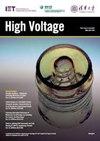高含金属污染对绝缘子交流闪络特性影响的研究
IF 4.9
2区 工程技术
Q1 ENGINEERING, ELECTRICAL & ELECTRONIC
引用次数: 0
摘要
在重金属工业区,由金属污染引起的输电线路外绝缘绝缘闪络问题日益突出。本文研究了U160B/155瓷绝缘子,考察了铁、铜和锌金属污染对其交流闪络特性的影响。并结合泄漏电流,分析了金属颗粒作用下绝缘子的闪络机理。研究结果表明,随着金属含量的增加,绝缘子的闪络梯度(EL)下降幅度可达2.3% ~ 17.2%。不同金属成分对绝缘子介电强度的影响机制一致,铜对绝缘子介电强度的影响作用略弱。然后,根据金属颗粒对绝缘子交流闪络的影响机理,提出了电闪络的计算公式,计算结果与实验条件基本一致。最后,不同金属成分对泄漏电流的影响相似,金属含量的增加导致临界泄漏电流的增加,并逐渐趋于饱和。本文的研究成果可为污染源中含有金属污染物的地区交流闪络预测、评价和外绝缘防护提供参考。本文章由计算机程序翻译,如有差异,请以英文原文为准。
Study on the Impact of Contamination Containing High Proportions of Metals on the AC Flashover Characteristics of Insulators
In heavy metal industrial areas, the issue of insulation flashover caused by metal contamination on the external insulation of transmission lines has become increasingly prominent. This paper investigates the U160B/155 porcelain insulator, examining how iron, copper and zinc metal contaminations affect its AC flashover characteristics. Furthermore, combining with leakage current, the flashover mechanism of the insulators under the influence of metal particles is analysed. The research results indicate that as the metal content increases, the insulator's flashover gradient (EL) decreases by up to 2.3%–17.2%. Different metal compositions exhibit consistent mechanisms, similarly impacting insulator's dielectric strength with copper showing slightly weaker effect. And then, based on the mechanism of metal particles' influence on the insulator's AC flashover, a formula for calculating EL is proposed and the calculated results are basically consistent with the experimental conditions. Finally, different metal compositions have similar effects on the leakage current, with an increase in metal content leading to an increase in the critical leakage current, which gradually tends to saturation. The research findings of this paper can provide references for AC flashover prediction, assessment and prevention of external insulation in areas with metal contaminants in pollution sources.
求助全文
通过发布文献求助,成功后即可免费获取论文全文。
去求助
来源期刊

High Voltage
Energy-Energy Engineering and Power Technology
CiteScore
9.60
自引率
27.30%
发文量
97
审稿时长
21 weeks
期刊介绍:
High Voltage aims to attract original research papers and review articles. The scope covers high-voltage power engineering and high voltage applications, including experimental, computational (including simulation and modelling) and theoretical studies, which include:
Electrical Insulation
● Outdoor, indoor, solid, liquid and gas insulation
● Transient voltages and overvoltage protection
● Nano-dielectrics and new insulation materials
● Condition monitoring and maintenance
Discharge and plasmas, pulsed power
● Electrical discharge, plasma generation and applications
● Interactions of plasma with surfaces
● Pulsed power science and technology
High-field effects
● Computation, measurements of Intensive Electromagnetic Field
● Electromagnetic compatibility
● Biomedical effects
● Environmental effects and protection
High Voltage Engineering
● Design problems, testing and measuring techniques
● Equipment development and asset management
● Smart Grid, live line working
● AC/DC power electronics
● UHV power transmission
Special Issues. Call for papers:
Interface Charging Phenomena for Dielectric Materials - https://digital-library.theiet.org/files/HVE_CFP_ICP.pdf
Emerging Materials For High Voltage Applications - https://digital-library.theiet.org/files/HVE_CFP_EMHVA.pdf
 求助内容:
求助内容: 应助结果提醒方式:
应助结果提醒方式:


